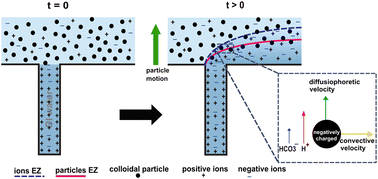Self-generated exclusion zone in a dead-end pore microfluidic channel†
Abstract
Particles can be manipulated by gradients of concentration (diffusiophoresis) and electric potential (electrophoresis) to transport them to desired locations. To establish these gradients, external stimuli are usually required. In this work, we manipulate particles through a self-generated concentration gradient within a PDMS-based microfluidic platform, without directly applying an external field. The interfacial chemistry of the PDMS results in a local increase of hydronium ions, leading to a concentration and electrical potential gradient in the system, which in turn generate a temporary exclusion zone at the pore entrance, extending up to half of the main channel, or 150 μm. With time, this exclusion zone diminishes as equilibrium in the ion concentration is reached. We study the dynamics of the exclusion zone thickness and find that the Sherwood number determines the size and stability of the exclusion zone. Our work shows, that even without introducing external ionic gradients, particle diffusiophoresis is significant in lab-on-a-chip systems. The interfacial chemistry of the microfluidic platform can have a significant influence on particle movement and this should be considered when designing experiments on diffusiophoresis. The observed phenomenon can be employed to design lab-on-a-chip-based sorting of colloidal particles.



 Please wait while we load your content...
Please wait while we load your content...